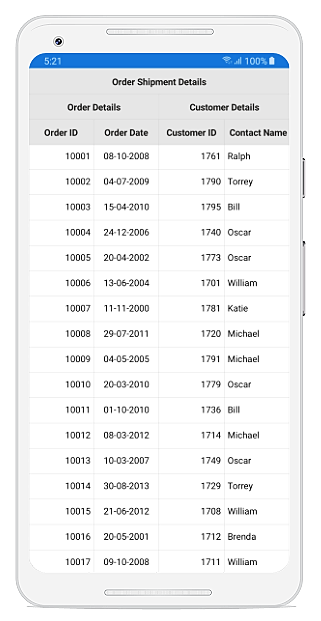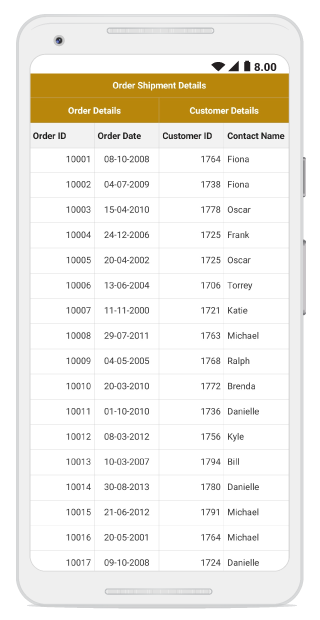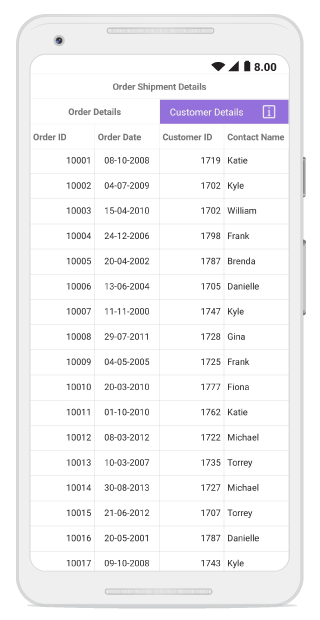Stacked Headers in Xamarin DataGrid (SfDataGrid)
10 Jan 202521 minutes to read
The SfDataGrid supports displaying additional unbound, multiple/multilevel header rows known as StackedHeaderRows that spans across the DataGrid columns. You can group one or more columns under each stacked header.
Each StackedHeaderRow contains StackedColumns, which contains a number of child columns. The StackedColumn.ChildColumns property contains the columns grouped under the stacked header row. The StackedColumn.MappingName is a unique name used for mapping a specific child column grouped under the same stacked header row, whereas the StackedColumn.Text contains the text displayed in the stacked header row.
Adding stacked header
The stacked headers can be added using the following steps:
- Create an object of
StackedHeaderRowfor adding stacked columns. - Add the columns using the
ChildColumnsproperty of StackedColumn. - Add the
StackedColumntoStackedColumnscollection. - Finally, add the
StackedHeaderRowtoStackedHeaderRowscollection of the SfDataGrid.
<syncfusion:SfDataGrid x:Name="dataGrid"
ItemsSource="{Binding Orders}">
<syncfusion:SfDataGrid.StackedHeaderRows>
<syncfusion:StackedHeaderRow>
<syncfusion:StackedHeaderRow.StackedColumns>
<syncfusion:StackedColumn
ChildColumns="OrderID,OrderDate,CustomerID,ContactName"
Text="Order Shipment Details"
MappingName="SalesDetails"
FontAttribute="Bold"
TextAlignment="Center"
/>
</syncfusion:StackedHeaderRow.StackedColumns>
</syncfusion:StackedHeaderRow>
<syncfusion:StackedHeaderRow>
<syncfusion:StackedHeaderRow.StackedColumns>
<syncfusion:StackedColumn
ChildColumns="OrderID,OrderDate"
Text="Order Details"
MappingName="OrderDetails"
FontAttribute="Bold"
TextAlignment="Center"
/>
<syncfusion:StackedColumn
ChildColumns="CustomerID,ContactName"
Text="Customer Details"
MappingName="CustomerDetails"
FontAttribute="Bold"
TextAlignment="Center"
/>
</syncfusion:StackedHeaderRow.StackedColumns>
</syncfusion:StackedHeaderRow>
</syncfusion:SfDataGrid.StackedHeaderRows>
</syncfusion:SfDataGrid>var stackedHeaderRow = new StackedHeaderRow();
stackedHeaderRow.StackedColumns.Add(new StackedColumn()
{
ChildColumns = "OrderID" + "," + "OrderDate" + "," + "CustomerID" + "," + "ContactName",
Text = "Order Shipment Details",
MappingName = "SalesDetails",
FontAttribute = FontAttributes.Bold,
TextAlignment = TextAlignment.Center,
});
dataGrid.StackedHeaderRows.Add(stackedHeaderRow);
var stackedHeaderRow1 = new StackedHeaderRow();
stackedHeaderRow1.StackedColumns.Add(new StackedColumn()
{
ChildColumns = "OrderID" + "," + "OrderDate",
Text = "Order Details",
MappingName = "OrderDetails",
FontAttribute = FontAttributes.Bold,
TextAlignment = TextAlignment.Center
});
stackedHeaderRow1.StackedColumns.Add(new StackedColumn()
{
ChildColumns = "CustomerID" + "," + "ContactName",
Text = "Customer Details",
MappingName = "CustomerDetails",
FontAttribute = FontAttributes.Bold,
TextAlignment = TextAlignment.Center
});
this.dataGrid.StackedHeaderRows.Add(stackedHeaderRow1);
Adding child columns
You can add the child columns to a particular stacked header row directly.
var childColumn = dataGrid.StackedHeaderRows[0].StackedColumns[0].ChildColumns;
dataGrid.StackedHeaderRows[0].StackedColumns[0].ChildColumns = childColumn + "," + "OrderDate";Removing child columns
Similarly, you can remove the child columns from a particular stacked header row directly.
var removingColumns = this.dataGrid.StackedHeaderRows[0].StackedColumns[0].ChildColumns.Split(',').ToList<string>();
string childColumns = string.Empty;
foreach(var stackedColumnName in removingColumns.ToList())
{
if (stackedColumnName.Equals("OrderID"))
{
removingColumns.Remove(stackedColumnName);
}
else
{
childColumns = childColumns + stackedColumnName + ",";
}
}
dataGrid.StackedHeaderRows[0].StackedColumns[0].ChildColumns = childColumns;Changing stacked header row height
You can change the height of StackedHeaderRows using the SfDataGrid.HeaderRowHeight property.
dataGrid.HeaderRowHeight = 50;You can also change the height of stacked header rows using the SfDataGrid.QueryRowHeight event.
dataGrid.QueryRowHeight += dataGrid_QueryRowHeight;
void dataGrid_QueryRowHeight(object sender, QueryRowHeightEventArgs e)
{
if(e.RowIndex < this.dataGrid.GetHeaderIndex())
{
// Using the following code, you can set a desired height based on the row index.
e.Height = 50;
// Uncomment the below line of code to apply auto fit height based on the contents of the stacked header row.
//e.Height = dataGrid.GetRowHeight(e.RowIndex);
e.Handled = true;
}
}Appearance
Font customization
Customize the font’s size, family and attribute of the text displayed in stacked header column using the StackedColumn.TextSize, StackedColumn.Font, and StackedColumn.FontAttribute properties, respectively. The default font size and font attribute are 14 and normal, respectively.
<syncfusion:StackedHeaderRow>
<syncfusion:StackedHeaderRow.StackedColumns>
<syncfusion:StackedColumn
ChildColumns="OrderID,OrderDate,CustomerID,ContactName"
Text="Order Shipment Details"
MappingName="SalesDetails"
TextSize = 16
Font="Helvetica Neue"
FontAttribute="Bold"
/>
</syncfusion:StackedHeaderRow.StackedColumns>
</syncfusion:StackedHeaderRow>var stackedHeaderRow = new StackedHeaderRow();
stackedHeaderRow.StackedColumns.Add(new StackedColumn()
{
ChildColumns = "OrderID" + "," + "OrderDate" + "," + "CustomerID" + "," + "ContactName",
Text = "Order Shipment Details",
MappingName = "SalesDetails",
TextSize = 14,
Font = "Helvetica Neue",
FontAttribute = FontAttributes.Bold
});
dataGrid.StackedHeaderRows.Add(stackedHeaderRow);Foreground and background customization
The appearance of stacked header row can be customized by returning a desired color in the GetStackedHeaderBackgroundColor() and GetStackedHeaderForegroundColor() overrides of the custom written style class derived from DataGridStyle and assigning it to the SfDataGrid.GridStyle property.
<ContentPage xmlns="http://xamarin.com/schemas/2014/forms"
xmlns:x="http://schemas.microsoft.com/winfx/2009/xaml"
xmlns:syncfusion="clr-namespace:Syncfusion.SfDataGrid.XForms;assembly=Syncfusion.SfDataGrid.XForms"
xmlns:local ="clr-namespace:DataGridSample;assembly=DataGridSample"
x:Class="DataGridSample.Sample">
<ContentPage.Resources>
<ResourceDictionary>
<local:Dark x:Key="dark" />
</ResourceDictionary>
</ContentPage.Resources>
<syncfusion:SfDataGrid x:Name="dataGrid"
GridStyle="{StaticResource dark}"
ItemsSource="{Binding OrdersInfo}" />
</ContentPage> //Apply custom style to SfDataGrid from code
SfDataGrid dataGrid = new SfDataGrid();
dataGrid.GridStyle = new Dark ();//Custom style class
public class Dark : DataGridStyle
{
public Dark ()
{
}
public override Color GetStackedHeaderBackgroundColor(int rowIndex)
{
return Color.DarkGoldenrod;
}
public override Color GetStackedHeaderForegroundColor(int rowIndex)
{
return Color.FromRgb(255, 255, 255);
}
}
Conditional styling
The SfDataGrid also allows to customize the appearance of stacked header rows conditionally based on its row index.
//Custom style class
public class Dark : DataGridStyle
{
public Dark ()
{
}
public override Color GetStackedHeaderBackgroundColor(int rowIndex)
{
if (rowIndex == 0)
{
return Color.Black;
}
else if (rowIndex == 1)
{
return Color.DarkOliveGreen;
}
}
public override Color GetStackedHeaderForegroundColor(int rowIndex)
{
if (rowIndex == 0 || rowIndex == 1)
{
return Color.FromRgb(255, 255, 255);
}
else
{
return Color.FromRgb(43, 43, 43);
}
}
}
Loading template in stacked column
The SfDataGrid allows you to load any desired view inside a StackedColumn using the StackedColumn.Template property.
<syncfusion:SfDataGrid.StackedHeaderRows>
<syncfusion:StackedHeaderRow>
<syncfusion:StackedHeaderRow.StackedColumns>
<syncfusion:StackedColumn
ChildColumns="OrderID,OrderDate"
Text="Order Details"
MappingName="OrderDetails"
FontAttribute="Bold"
TextAlignment="Center"
/>
<syncfusion:StackedColumn
ChildColumns="CustomerID,ContactName"
MappingName="CustomerDetails"
>
<syncfusion:StackedColumn.Template>
<DataTemplate>
<Grid BackgroundColor="MediumPurple">
<Grid.ColumnDefinitions>
<ColumnDefinition Width="*"/>
<ColumnDefinition Width="50"/>
</Grid.ColumnDefinitions>
<Label Text="Customer Details" TextColor="White" HorizontalTextAlignment="Center" VerticalTextAlignment="Center" Grid.Column="0"/>
<Image Source="customer_details.png" VerticalOptions="Center" HorizontalOptions="Start" Aspect="AspectFit" Grid.Column="1"/>
</Grid>
</DataTemplate>
</syncfusion:StackedColumn.Template>
</syncfusion:StackedColumn>
</syncfusion:StackedHeaderRow.StackedColumns>
</syncfusion:StackedHeaderRow>
</syncfusion:SfDataGrid.StackedHeaderRows>var stackedHeaderRow1 = new StackedHeaderRow();
stackedHeaderRow1.StackedColumns.Add(new StackedColumn()
{
ChildColumns = "OrderID" + "," + "OrderDate",
Text = "Order Details",
MappingName = "OrderDetails",
FontAttribute = FontAttributes.Bold,
TextAlignment = TextAlignment.Center
});
stackedHeaderRow1.StackedColumns.Add(new StackedColumn()
{
ChildColumns = "CustomerID" + "," + "ContactName",
MappingName = "CustomerDetails",
Template = new DataTemplate(() =>
{
var gridView = new Grid()
{
BackgroundColor = Color.MediumPurple,
ColumnDefinitions = new ColumnDefinitionCollection()
{
new ColumnDefinition{Width = new GridLength(1, GridUnitType.Star) },
new ColumnDefinition{ Width = 50}
}
};
var imageView = new Image()
{
Source = ImageSource.FromFile("customer_details.png"),
Aspect = Aspect.AspectFit,
VerticalOptions = LayoutOptions.Center,
HorizontalOptions = LayoutOptions.Start
};
var label = new Label()
{
Text = "Customer Details",
TextColor = Color.White,
VerticalTextAlignment = TextAlignment.Center,
HorizontalTextAlignment = TextAlignment.Center
};
gridView.Children.Add(label, 0, 0);
gridView.Children.Add(imageView, 1, 0);
return gridView;
})
});
this.dataGrid.StackedHeaderRows.Add(stackedHeaderRow1);
NOTE
You can refer to our Xamarin DataGrid feature tour page for its groundbreaking feature representations. You can also explore our Xamarin.Forms DataGrid example to knows various chart types and how to easily configured with built-in support for creating stunning visual effects.